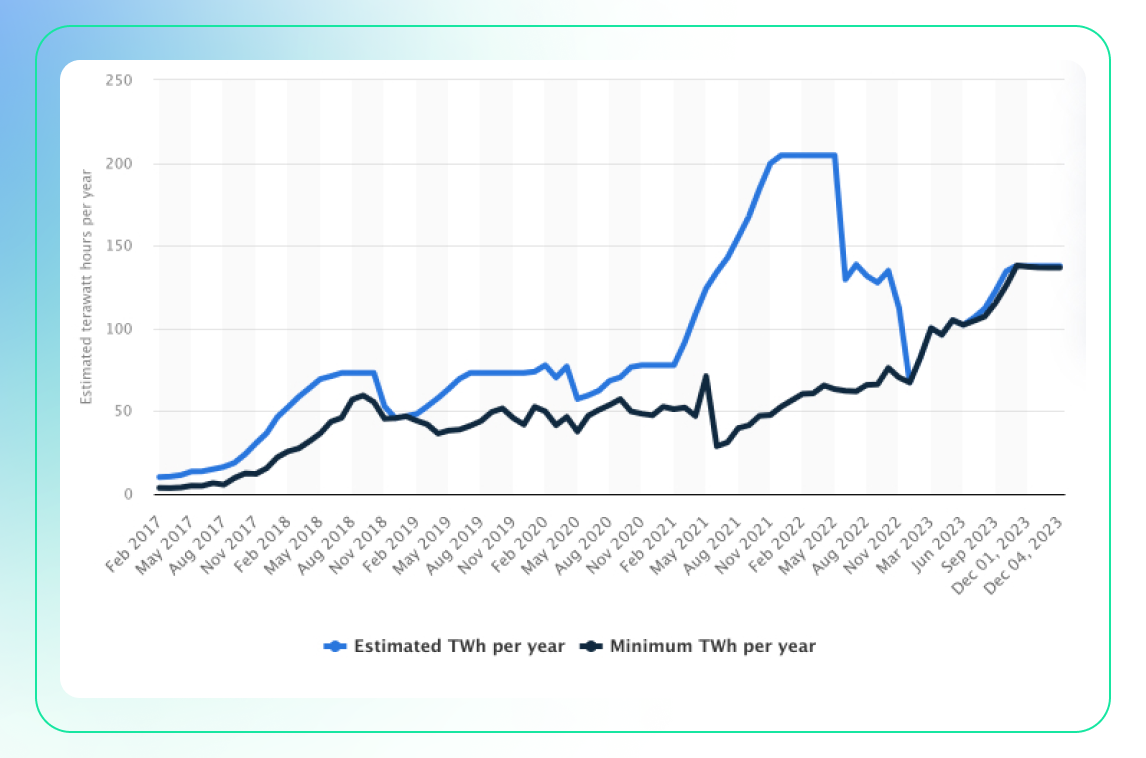
Exploring the Environmental Aspects of Cryptocurrency Mining
Beyond the crypto hype lies an unsavory underbelly: the staggering environmental damage of Bitcoin's energy addiction. But could green solutions offer a way forward?
Cryptocurrencies like bitcoin present an exciting new tech innovation and money-making opportunity for some. But for those assessing environmental impact, the reality is far from benign.
The truth is, cryptocurrency mining is at odds with environmental sustainability due to its colossal energy consumption and the pollution that follows. Grasping the gravity of these environmental effects, alongside the reasons activists and policymakers are advocating for reform, is critical for those dedicated to preserving a healthy planet.
In our exploration, we'll dissect the ecological footprint of crypto, its implications for you, the merits of your involvement, and how you can contribute to a more eco-friendly cryptocurrency landscape if you choose to participate.
How Does Mining Work?
Getting your head around the environmental impact of mining for cryptocurrencies like bitcoin means getting to grips with how the whole mining thing works.
At the heart of it all is this tech called blockchain, a decentralized ledger system maintained across various points, known as nodes.
Now, cryptocurrencies don’t have a central authority for managing transactions. They employ advanced cryptographic techniques known as cryptomining to secure and authenticate transactions, as well as to manage the generation of new currency units. The environmental footprint of mining cryptocurrencies, particularly bitcoin, stems chiefly from the predominant mining mechanism called proof of work (PoW).
PoW demands an extensive amount of processing capacity, as miners go full throttle with their computers, cracking complex codes and using up a ton of electricity just to confirm a bunch of transactions.
In the bitcoin network, miners vie to decrypt a complex puzzle in each block. Hammering away with special software, they attempt to crack the mathematical conundrum through a process of trial and error, persisting until a solution is found. The first to crack the code gets a prize in bitcoins, which is sort of like getting a gold star for all that number crunching they do to keep the network in shipshape.
The PoW protocol favors miners with the most robust computing resources, as they can throw more guesses out there and up their odds to win the bitcoin bounty.
An alternative approach called proof of stake (PoS) needs far less energy and computing power. PoS limits participation and requires miners to provide a monetary deposit to verify transactions. It's a whole lot easier on the power bill and keeps things humming without the energy-hogging hustle.
👉 Interested in learning more about PoW vs PoS? Then check out this article on our blog: Unlocking Blockchain: A Deep Dive into PoW and PoS Consensus Algorithms
So, Is Crypto Currency Bad for the Environment? Well, Yes.
Cryptomining's thirst for power has got everyone talking — from eco-warriors to suits in government and the boardroom — because let's face it, it guzzles energy, cranks out carbon, and churns through gear like there's no tomorrow.
👉 Take this nugget from the Cambridge Bitcoin Electricity Consumption Index (CBECI): Bitcoin's yearly power use could keep the lights on at the University of Cambridge for over a thousand years.
Although more than a third of the world's Bitcoin mining happens in the U.S., but its eco-footprint is leaving marks all over the planet.
In early 2022, for instance, bitcoin's electricity consumption reached an all-time high of 204.5 TWh, exceeding the entire power needs of Finland.

This vast energy drain results in massive carbon emissions. From 2020-2021, bitcoin mining generated over 85 million metric tons of carbon dioxide equivalent. For perspective, that's comparable to emissions from burning 96,000 tons of coal or fueling nearly 10 million gasoline-powered cars for a year.
However, the cryptocurrency's environmental footprint extends beyond just energy use and emissions.
The heat generated from bitcoin's vast computing network poses additional concerns. Producing and disposing of the specialized hardware used in bitcoin mining also contributes to global electronic waste, with toxic chemicals and heavy metals polluting landfills.
Annually, bitcoin's e-waste stacks up to what the whole of the Netherlands bins in IT gear. By 2050, we could see that trash tip the scales at over 64,000 tons.
On top of energy demands and hardware waste, bitcoin leads to air and water pollution when discarded equipment is improperly recycled.
Overall, the scale of bitcoin mining magnifies its multifaceted environmental footprint through increased electricity reliance, greenhouse gas emissions, heat generation, and e-waste production. Naturally, these issues have drawn global concern. Activists, governments, and companies alike are calling for change to rein in bitcoin mining's environmental damage. The fix needs to be global because Bitcoin's climate rap sheet is way too big for any one country to clean up.
What Is There to Do to Address the Environmental Impact of Cryptocurrency?
You might think once the environmental red flags went up around bitcoin mining, governments would be all over it — slapping bans or at least putting up some serious guardrails. But actually, it's not that simple.
Across the U.S., the reaction to bitcoin mining is a mixed bag, with each state playing its own tune. Some, like North Dakota and Wyoming, are rolling out tax incentives for miners who cozy up to the oil industry. They're turning what would've been wasted gas into fuel for the crypto craze. But then you've got places like New York pulling the plug. In 2022, their environmental folks said nope to a bitcoin mining outfit that wanted to puff out more greenhouse gases than the state's targets could stomach.
The heat's cranking up to get bitcoin and its techy pals in the Web3 scene to clean up their act. It's not just the green brigade waving flags; businesses are sweating over how bitcoin’s eco-rep fits with their shiny clean goals.
Amidst all the hand-wringing, some in the Web3 world are actually doing something about it. Take Ethereum — they did a full 180 in September 2022, ditching the energy-hungry Proof of Work (PoW) for the chillaxed Proof of Stake (PoS) and slashed their power diet by over 99%.
The big question hanging over bitcoin is whether it can make a similar move without causing a civil war. After all, changing bitcoin would need a big group hug of agreement. And even then, you'd likely end up with a bitcoin feud — some sticking with the old ways, others breaking away to the new energy-saving PoS style.
For the bitcoin crowd, such a switcheroo ain't a walk in the park. After all, there's a heap of cash locked up in all that mining gear. But some heads are nodding to the idea of greening up the gig, like plugging into renewables and reusing that toasty waste heat from mining rigs — stuff that's already brewing in spots.
Renewables are the new black for bitcoin mines. Solar, wind, and hydro are stepping in, offering miners a guilt-free way to keep the coins flowing without the carbon hangover. And miners are getting wise, moving their operations where the clean energy flows.
The gear's getting a green makeover too. Some outfits are swapping out those ravenous ASICs for the leaner, greener GPUs from the gaming world. These could be the key to a more eco-friendly mining future.
Then there are the crypto aficionados, offsetting their footprint by backing green projects or buying carbon credits to balance out their emissions — a sort of environmental karma for the digital age.
To put it briefly, wheels are turning. While bitcoin's path forward is uncertain, promising steps are happening, from Ethereum's overhaul to community initiatives around renewables and efficiency. But substantially reducing bitcoin's environmental impact remains an uphill climb.
Bottom Line
Navigating the bitcoin terrain means we've got to juggle pushing the envelope with tech and playing nice with the planet. Sure, digital currencies could flip the script on the economy and give tech a serious boost, but not if it means throwing Mother Nature under the bus. Hunting down eco-friendly fixes is key to making sure the crypto perks don't come with a planet-sized side effect.
👉 Looking for ways to trade your crypto? Look no more. Bitsgap provides the ultimate all-in-one solution. As a top crypto aggregator, we connect you to over 15 major platforms through one intuitive interface. No more tab-switching and complex workflows. Our robust platform centralizes trading, bots, portfolio management, and more. See why we are the go-to for crypto traders worldwide — sign up for a 7-day free trial today.
FAQs
Is Crypto Environmental Impact Damaging?
Certainly, the ecological toll of cryptocurrencies, particularly heavy-hitters like Bitcoin, is profound. The root of the issue lies in the colossal energy consumption required for mining activities. Bitcoin's energy usage alone eclipses that of some entire nations, leading to a significant carbon footprint. Fossil fuels, particularly coal, are major energy sources for these operations, contributing to greenhouse gas emissions. Additionally, a substantial amount of electronic waste is produced as mining hardware becomes obsolete. Mining hotspots can overburden local power infrastructures, sometimes causing widespread outages. Added to this are secondary environmental effects, such as the heat produced by mining operations. Despite the financial inclusion and innovation that cryptocurrencies offer, their environmental repercussions cannot be ignored.
Why Is Cryptocurrency Bad?
Whether cryptocurrency is deemed "bad" really hinges on one's viewpoint and the criteria they're using to judge it. Bitcoin and its peers face scrutiny for a variety of reasons, including their impact on the environment, the economy, and the challenges they pose to regulation. Conversely, enthusiasts of cryptocurrencies highlight their potential upsides, which include making financial services more accessible, reducing costs for cross-border transactions, enhancing privacy, bolstering security with encryption, and driving fintech innovation. In the end, the label of "bad" for cryptocurrencies will be contingent on how effectively the industry can mitigate these criticisms while amplifying their benefits.
What’s Most Sustainable Cryptocurrency?
The eco-friendliness of a cryptocurrency is largely determined by how much energy it uses and the type of consensus mechanism it employs to verify transactions and secure its blockchain. Among the cryptocurrencies that stand out for their sustainability based on these aspects are Nano, Stellar (XLM), Cardano (ADA), Ripple (XRP), and Algorand (ALGO). Take Nano as an example; it operates on a distinctive block-lattice architecture and employs the Open Representative Voting (ORV) consensus mechanism, which allows it to process transactions with very low energy usage since it doesn't use conventional mining practices.
